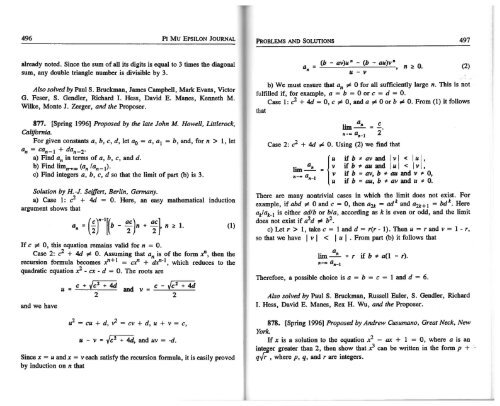Vol. 10 No 6 - Pi Mu Epsilon
Vol. 10 No 6 - Pi Mu Epsilon
Vol. 10 No 6 - Pi Mu Epsilon
- No tags were found...
You also want an ePaper? Increase the reach of your titles
YUMPU automatically turns print PDFs into web optimized ePapers that Google loves.
496 PI MU EPSILON JOURNAL<br />
PROBLEMS AND SOLUTIONS 497<br />
already noted. Since the sum of all its digits is equal to 3 times the diagonal<br />
sum, any double triangle number is divisible by 3.<br />
Also solved by PaulS. Bruckman, James Campbell, Mark Evans, Victor<br />
G. Feser, S. Gendler, Richard I. Hess, David E. Manes, Kenneth M.<br />
Wilke, Monte J. Zerger, and the Proposer.<br />
877. [Spring 1996] Proposed by the late John M. Howell, Littlerock,<br />
California.<br />
For given constants a, b, c, d, let Do = a, a 1 = b, and, for n > 1, let<br />
an = can-1 + dan-2·<br />
a) Find an in terms of a, b, c, and d.<br />
b) Find limn--- 011 (an lan-1>·<br />
c) Find integers a, b, c, d so that the limit of part (b) is 3.<br />
Solution by H. -J. Seiffert, Berlin, Germany.<br />
a) Case 1: + 4d = 0. Here, an easy mathematical induction<br />
argument shows that<br />
a,. ( c)"- 1 = l ~ ~( b ac) ac]<br />
- 2 n + 2 , n ~ 1. (1)<br />
If c ¢ 0, this equation remains valid for n = 0.<br />
Case 2: + 4d ¢ 0. Assuming that an is of the form X', then the<br />
recursion formula becomes X'+ 1 = eX' + dx!'- 1 , which reduces to the<br />
quadratic equation x - ex - d = 0. The roots are<br />
and we have<br />
c + .lc2 + 4d c - .fc2 + 4d<br />
u = v and v = -=-----~v'------<br />
2 2<br />
u 2 =cu+d Vl=cv+d u+v=c<br />
' , '<br />
u - v = Jc 2 + 4d, and uv = -d.<br />
Since x = u and x = v each satisfy the recursion formula, it is easily proved<br />
by induction on n that<br />
(b - av)u" - (b - au)v"<br />
a = , n ~ 0.<br />
II U- V<br />
b) We must ensure that an ¢ 0 for all sufficiently large n. This is not<br />
fulfilled if, for example, a = b = 0 or c = d = 0.<br />
Case 1: + 4d = 0, c ¢ 0, and a ¢ 0 orb ¢ 0. From (1) it follows<br />
that<br />
lim a,. = E.<br />
,._.., a,._ 1<br />
2<br />
Case 2: + 4d ¢ 0. Using (2) we find that<br />
if b ~ av and lvl < lui,<br />
if b ~au and lui < I vi,<br />
if b = av, b ~ au and v ~ 0,<br />
if b = au, b ~ av and u ~ 0.<br />
There are many nontrivial cases in which the limit does not exist. For<br />
example, if abd ¢ 0 and c = 0, then a2k = adk and a2k+ 1 = bdk. Here<br />
at'at_ 1 is either adlb or bla, according as k is even or odd, and the limit<br />
does not exist if a 2 d ¢ b 2 •<br />
c) Let r > 1, take c = 1 and d = r(r- 1). Then u =rand v = 1- r,<br />
so that we have I vI < I u I . From part (b) it follows that<br />
a<br />
lim-" = r if b ~ a(l - r).<br />
,._ .. a,._.<br />
Therefore, a possible choice is a = b = c = 1 and d = 6.<br />
Also solved by Paul S. Bruckman, Russell Euler, S. Gendler, Richard<br />
I. Hess, David E. Manes, Rex H. Wu, and the Proposer.<br />
878. [Spring 1996] Proposed by Andrew Cusumano, Great Neck, New<br />
York.<br />
If x is a solution to the equation x - ax + 1 = 0, where a is an<br />
in~er greater than 2, then show that~ can be written in the form p + ·~<br />
qyr , where p, q, and r are integers.<br />
(2)
















